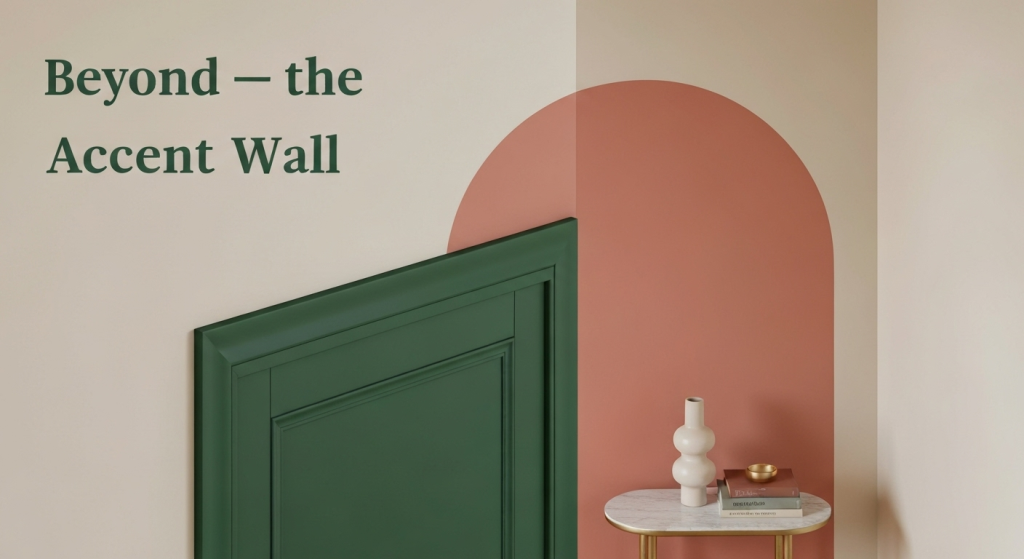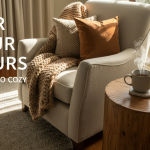Tired of the same old advice? For years, the go-to solution for adding a splash of color has been the accent wall. While it can work, it often feels a bit predictable, like the one “safe” move everyone makes. If you crave color but want a home that feels more curated, personal, and intentional, it’s time to think beyond painting just one wall. The truth is, color is one of the most powerful tools in home design, and using it in unexpected ways can completely transform the mood and character of your space.
My name is William Johnson, and for the better part of a decade, I’ve been helping people bring their homes to life through thoughtful design. My passion isn’t just about following trends; it’s about exploring how elements like color and light can shape our daily experiences. I’ve seen firsthand how a small, strategic choice—like the color of a window frame or the inside of a bookshelf—can have a more profound impact than a gallon of paint on a single wall. This guide is built on that experience, sharing creative techniques I’ve used to make spaces feel truly special and reflective of the people who live in them.
The Psychology of Color: More Than Just Paint
Before we dive into specific techniques, let’s talk about why this matters. Color isn’t just decoration; it’s a language that speaks directly to our emotions. A deep blue can feel calming and stable, while a sunny yellow can evoke happiness and energy. The goal isn’t just to put color on a surface. It’s to use that color to craft a feeling, guide the eye, and add architectural interest where none existed before.
Strategic color placement is about creating moments of surprise and delight. It’s about making a room feel taller, cozier, or more expansive. By moving color off that one expected wall and onto ceilings, doors, and trims, you create a more immersive and thoughtfully designed environment. It tells a story that is uniquely yours.
The Fifth Wall: Painting Your Ceiling for Dramatic Effect
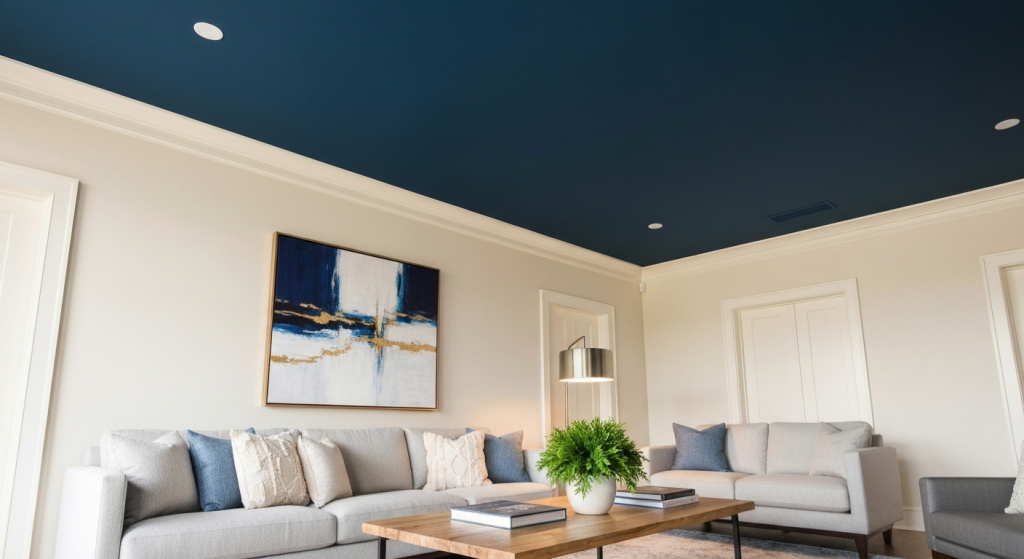
We spend so much time thinking about the four walls around us that we often forget the fifth one right above our heads. A painted ceiling is one of the most underutilized and impactful design choices you can make. It can be a subtle whisper of color or a bold, dramatic statement that completely redefines a room.
How a Colored Ceiling Transforms a Room
The effect of a colored ceiling largely depends on the shade you choose and the height of your room. It’s not a one-size-fits-all solution. In my work, I’ve seen how a dark ceiling can make a cavernous room feel intimate, while a light, airy color can lift a low ceiling and make the space feel bigger.
- Dark and Moody Ceilings: Think navy blue, charcoal gray, or even a deep forest green. These colors are fantastic for creating a cozy, enveloping atmosphere. In a bedroom, a dark ceiling can feel like a comforting blanket, promoting rest. In a dining room, it adds a layer of drama and sophistication, making evening meals feel more special. This is a brilliant trick for rooms with very high ceilings, as it can bring the scale of the room down to a more human level.
- Light and Airy Ceilings: Soft pastels like pale sky blue, blush pink, or a barely-there mint green can add a subtle wash of color without being overwhelming. A pale blue ceiling, for example, mimics the sky and creates a sense of openness and calm. This is a great technique for rooms with lower ceilings, as it draws the eye upward and gives the illusion of more height.
- Bold and Saturated Ceilings: Want to make a real statement? A ceiling painted in a vibrant mustard yellow, a rich emerald, or a terracotta orange is pure energy. This approach works best in spaces where you want to foster creativity and conversation, like a home office, a playroom, or even a powder room where you can afford to be more adventurous.
Getting it Right: Tips from Experience
Painting a ceiling requires a bit more thought than a wall. Light hits it differently, and the finish you choose can make or break the look.
A common mistake I see is people forgetting about the paint finish. For a ceiling, a matte or flat finish is almost always the safest bet. It hides imperfections beautifully and gives the color a rich, velvety depth. A high-gloss finish, on the other hand, is a very bold, high-fashion move. It will reflect a ton of light and create a lacquered, mirror-like effect, but be warned: it will also highlight every single bump and flaw in the plaster.
The key is to connect the ceiling color to other elements in the room. Pull a color from a rug, a piece of art, or the upholstery on a chair. This creates a cohesive look and makes the choice feel intentional rather than random.
| Ceiling Color Strategy | Effect on the Room | Best For | Pro Tip |
| Dark (Navy, Charcoal) | Creates a cozy, intimate, and dramatic feel. Visually lowers the ceiling. | Bedrooms, dining rooms, dens, or rooms with very high ceilings. | Use a matte finish to absorb light and enhance the enveloping effect. |
| Light (Pale Blue, Blush) | Feels airy, expansive, and subtly uplifts the space. Visually raises the ceiling. | Rooms with low ceilings, nurseries, bathrooms, and laundry rooms. | Pair with crisp white walls to maximize the feeling of height and openness. |
| Bold (Emerald, Mustard) | Adds energy, a surprising focal point, and a dose of personality. | Creative spaces, home offices, powder rooms, and entryways. | Keep the walls relatively neutral to let the ceiling be the star of the show. |
The Unexpected Pop: Painting Interior Doors
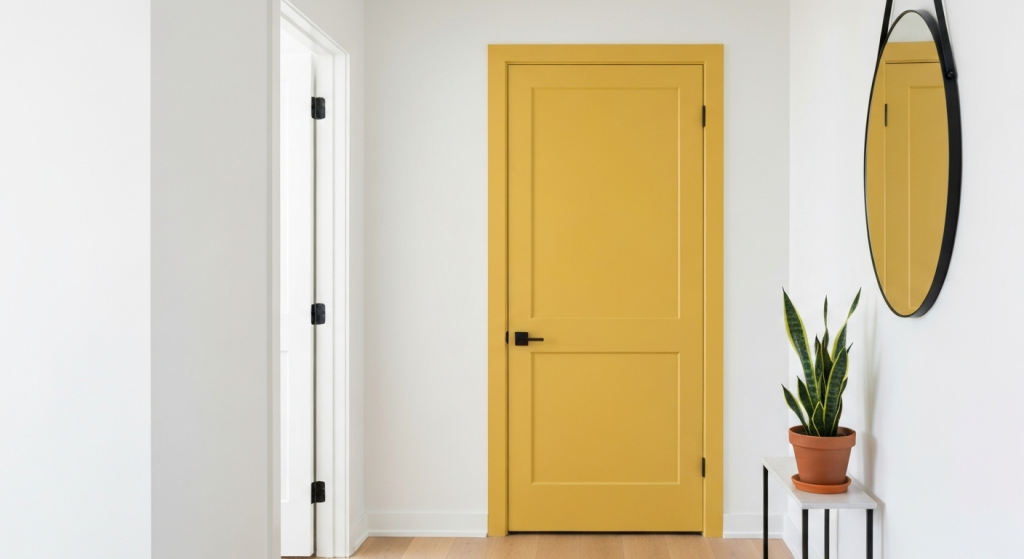
Think of your interior doors as blank canvases just waiting for a bit of personality. Painting a door is a low-commitment, high-impact project that can inject a serious dose of style into your home. It’s a “surprise and delight” element that greets you as you move from one space to another. Because it’s a relatively small surface, you can be much braver with your color choice than you might be with an entire wall.
Choosing Your Door Color
The color you choose can set the tone for the room it leads into or act as a grounding accent in a hallway.
- Classic Black or Charcoal: A black door is timelessly chic. It adds a touch of sophistication and weight, acting like a beautifully crafted picture frame for the view into the next room. It works with nearly any color scheme, from neutral to vibrant, and provides a graphic punch that feels both modern and traditional.
- Playful Brights: A sunny yellow pantry door, a coral laundry room door, or a teal home office door can bring a smile to your face every time you see it. These pops of color are perfect for secondary spaces where you can take more risks. They infuse the home with energy and fun without overwhelming the main living areas.
- Subtle Hues: You don’t have to go bold to make an impact. A door painted in a soft sage green, a dusty blue, or a warm greige can add a layer of custom detail that feels quiet and elegant. This works beautifully in homes with a neutral wall palette, adding depth and character.
Practical Considerations
One question I get asked all the time is whether to paint both sides of the door. My general rule is this: if the door opens into a hallway, paint the side facing the hall to match the other doors for consistency. The side facing into the room can then be painted your chosen accent color. This gives the room its own unique personality without disrupting the flow of the main thoroughfare.
Pros and Cons of Painting Interior Doors
| Pros | Cons |
| High Impact, Low Commitment: A small change with a huge visual payoff. | Requires Careful Prep: Doors need to be properly cleaned, sanded, and primed for a durable finish. |
| Affordable Project: Often requires only a quart of paint and a few hours of work. | Can Clash if Not Coordinated: The color should complement the rooms on both sides of the door. |
| Easy to Reverse: If you get tired of the color, it’s a simple weekend project to repaint it. | Shows Wear and Tear: Doors get a lot of use, so chips and scuffs can happen over time. |
For durability, always use a satin or semi-gloss finish on doors. These finishes are much easier to wipe clean than a flat or matte finish, which is crucial for a high-touch surface.
Frame the View: The Power of Painted Window Trims
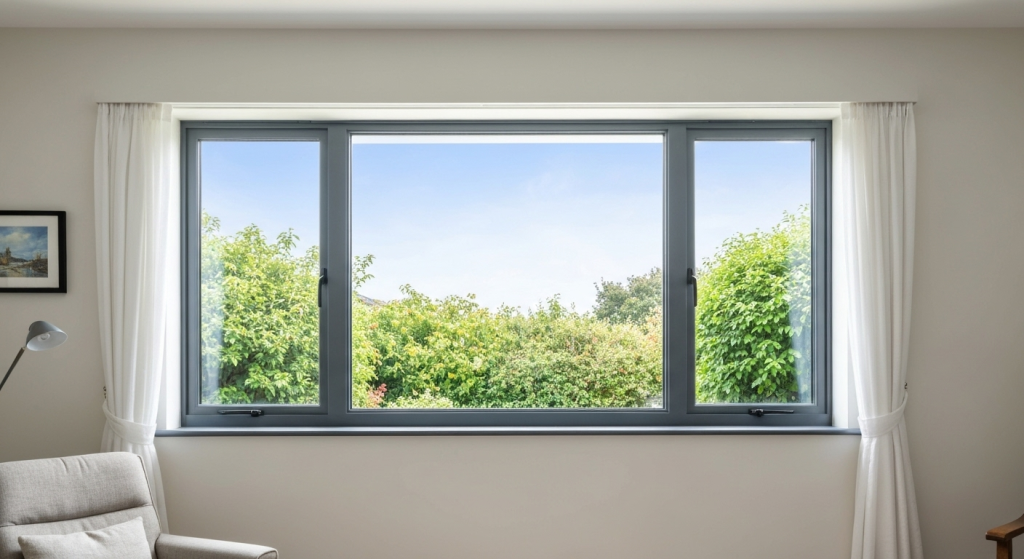
Painting your window trim, or “sashes,” is a subtle but incredibly effective technique. Instead of looking at the wall, this method encourages you to look through it. It draws the eye outward, framing the view of your garden, the sky, or the city street like a piece of living art. It also adds a layer of architectural detail that can make a simple room feel much more custom and refined.
Color Strategies for Window Trims
The goal here is to use color to define the shape of the window and enhance the connection between your indoor and outdoor space.
- High-Contrast Trim: The most classic example is black trim on white walls. This creates a bold, graphic look that feels modern and industrial. It provides sharp, clean lines that define the architecture of the room. I’ve found this works exceptionally well in minimalist or contemporary homes where the focus is on form and structure.
- Low-Contrast Trim: For a softer, more layered effect, choose a trim color that is just a few shades darker or lighter than your wall color. For instance, a warm greige trim on soft beige walls. This technique adds depth and sophistication without shouting for attention. It’s a very high-end look that makes a room feel complete.
- A Pop of Nature-Inspired Color: I once worked on a project for a client whose living room overlooked a beautiful, lush garden. The room itself was neutral, but it felt disconnected from the view. We painted the window trims a deep, mossy green. Instantly, the room and the garden felt like one cohesive space. The green trim pulled the color from the outside in, creating a seamless transition.
A Pro’s Advice on Trim
This is one area where prep work is non-negotiable. Meticulous taping with high-quality painter’s tape is the key to getting those crisp, clean lines that make this look so sharp. Rushing this step will only lead to frustration. Take your time, use a good angled brush, and apply two thin coats for the best coverage. The payoff is a professional-looking finish that elevates the entire room.
Beyond Four Walls: Creative Color Blocking
Color blocking is a technique borrowed from the fashion world, and it involves using distinct blocks of color to create geometric interest. It’s more dynamic than an accent wall because it’s not confined to existing architectural lines. You create your own shapes and zones, adding a playful and artistic touch to your home.
Color Blocking on Walls
This technique allows you to define a space or create a focal point without any construction.
- Painted Arch: A painted arch behind a bed can act as a virtual headboard, adding softness and a focal point. Similarly, an arch behind a desk can define a workspace within a larger room.
- Half-Painted Wall: Painting the bottom half of a wall a darker color can ground the room and add visual weight, much like traditional wainscoting. It’s a modern take on a classic idea.
- Geometric Shapes: You can use color to create large-scale geometric designs that add movement and energy. This is a fantastic way to define a reading nook in the corner of a living room or a play area in a child’s bedroom.
Taking it to Furniture: A Fresh Coat for Old Pieces
Color blocking isn’t just for walls. It’s a fantastic way to upcycle and breathe new life into tired furniture. An old wooden dresser can be transformed by painting the drawers in an ombre sequence, moving from light to dark. A simple dining table can become a statement piece by painting just the legs a vibrant color. This introduces color in a contained, controlled way and allows you to experiment with bolder shades without committing them to your walls.
| Feature | Traditional Accent Wall | Strategic Color Blocking |
| Focus | An entire, pre-existing wall. | A specific, artistically defined shape or zone. |
| Impact | Can sometimes feel heavy or one-dimensional. | More dynamic, custom, and architectural. |
| Versatility | Limited to one surface and its boundaries. | Can be applied to walls, furniture, floors, and ceilings. |
| Creativity | A straightforward choice. | Allows for endless artistic expression and personalization. |
Look Down: Don’t Forget the Floor
For the truly daring, the floor offers a vast canvas for color and pattern. This is definitely a bigger commitment, but the results can be absolutely spectacular. Painted floors can add charm, whimsy, and a completely custom feel to a space.
In a mudroom or enclosed porch, a painted checkerboard or striped pattern on a wood floor can be incredibly charming and durable. For a basement, sunroom, or studio with a concrete floor, a solid coat of bold epoxy floor paint can transform a utilitarian space into a stylish one. You can even use stencils to create intricate, tile-like patterns for a fraction of the cost of real tile. Just be sure to use paint specifically formulated for floors and seal it properly to withstand foot traffic.
The Finishing Touch: Colorful Built-ins and Bookshelves
If you’re feeling a bit color-shy, this is the perfect place to start. Painting the inside back of a bookshelf or a glass-fronted cabinet creates a delightful “jewel box” effect. It’s a low-risk, high-reward project that adds a surprising layer of depth and personality.
This technique works because it highlights the objects on display. Your white ceramic vases, books, and treasured objects will pop against a contrasting background. A deep navy blue background can make neutral decor feel crisp and sophisticated. A bright coral or sunny yellow can bring a burst of joy to an otherwise neutral living room. It’s a small detail that shows a great deal of thought and makes your storage feel like a curated display.
Frequently Asked Questions
What’s the best paint finish for these projects?
For ceilings, a flat or matte finish is best as it hides imperfections. For doors, trims, and furniture, a satin or semi-gloss finish is ideal because it’s durable and easy to clean. For floors, you must use specially formulated floor paint for safety and durability.
How do I test a color before committing?
Never trust a small paint chip. Always buy a sample pot and paint a large poster board (at least 2×2 feet). Move the board around the room at different times of day to see how the color changes in different light. For something like a door or trim, you can tape the board right up against the surface.
Can I use these techniques in a small room?
Absolutely! In fact, some of these techniques are perfect for small spaces. A pale blue ceiling can make a small room feel taller. Painting the window trim a dark color can draw the eye outside, creating a sense of depth. The key is to be intentional and not overcrowd the space with too many competing ideas.
How do I ensure the colors I choose work well together?
A good rule of thumb is the 60-30-10 rule. Your dominant color (usually your walls) should take up about 60% of the space, a secondary color (like upholstery or rugs) about 30%, and your accent color (for doors, trims, or pillows) about 10%. Also, look at a color wheel. Colors that are opposite each other (complementary) create energy, while colors next to each other (analogous) create harmony.
Conclusion: Your Home, Your Color Story
Adding color to your home should be an adventure, not a chore limited by outdated rules. By moving beyond the accent wall, you open up a world of creative possibilities. Whether you start small with the back of a bookshelf or go bold with a dramatic painted ceiling, these techniques allow you to infuse your space with personality, depth, and style.
The most beautiful homes are the ones that tell the story of the people who live inside them. So pick up a brush, choose a color that makes you happy, and start creating a space that feels uniquely and wonderfully yours.
